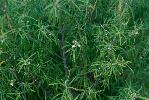Species profile—Zieria verrucosa
Classification
Plantae (plants) → Equisetopsida (land plants) → Rutaceae → Zieria verrucosa

Sighting data
Species details
- Kingdom
- Plantae (plants)
- Class
- Equisetopsida (land plants)
- Family
- Rutaceae
- Scientific name
- Zieria verrucosa J.A.Armstr.
- WildNet taxon ID
- 3296
- Nature Conservation Act 1992 (NCA) status
- Vulnerable
- Environment Protection and Biodiversity Conservation Act 1999 (EPBC) status
- Vulnerable
- Conservation significant
- Yes
- Confidential
- No
- Endemicity
- Native
- Pest status
- Nil
- Short Notes
- BRI 174671 (Holotype), 021720 (Isotype), status annotated by author
- Description
- Zieria verrucosa is a many branched, conspicuously hairy shrub, to 1.5 m tall. The leaves are opposite, with three leaflets. The leaflets are densely glandular, tuberculate and often strongly aromatic and are 8 to 50 mm long by 1 to 5 mm wide, dark green with scattered hairs on the upper surface and whitish, velvety, hairy on the lower surface. The leaflet margins are tuberculate and curved or curled towards the lower surface. The inflorescences are in the leaf axils and shorter than the subtending leaves, with up to 60 flowers. The flowers are creamy white to pink and 4 to 6mm in diameter. The fruit are hairless and gland-dotted DSEWPC (2012). The seeds are obovoid, 1.9 to 2 mm by 1.1 to 1.2 mm wide, black to dark brown, shiny and longitudinally striated. (Duretto and Forster, 2007).
Zieria verrucosa, Z. vagans and Z. distans form a threesome of closely related taxa. Z. vagans differs from Z. verrucosa in the leaves that are held patently or erect (verses drooping), the leaflets that are narrow-elliptic (verses linear) with a length/width ratio of 7.5 to 10.8 (verses 10 to 25.3) and that are not obviously glandular above (verses strongly glandular verrucose) and not obviously glandular sepals (verses scattered glandular verrucose). Both Z. vagans and Z. verrucosa share similar sized leaves and narrow-oblong bracts on the inflorescences (Duretto and Forster, 2007). - Distribution
- Zieria verrucosa is endemic to Queensland within the Brigalow Belt and Southeast Queensland bioregions with populations centred near Abbeywood, Proston, Monogoribly, 'Narayen' and Nanango (Queensland Herbarium, 2012).
- Distributional limits
- -25.7359189, 150.790809
-26.7702778, 152.6760598 - Range derivation
- Range derived from extent of the taxon's verified records
- Habitat
- Zieria verrucosa usually occurs in semi-evergreen vine thicket on red krasnozem soil. At Nanango the species is found in Eucalyptus crebra woodland on red clay soil (Queensland Herbarium, 2012).
- Reproduction
- Flowers and fruits have been collected from August to February (Queensland Herbarium, 2012).
- Threatening processes
- The main identified threats to Zieria verrucosa are continuing land clearing for agriculture and habitat degradation by cattle grazing (Duretto and Forster, 2007).
The main potential threats to the species include frequent hot fires, which would deplete the soil seed bank, and competition from introduced pasture grasses such as green panic (Megathyrsus maximus var. pubiglumis) and to a lesser extent buffel grass (Cenchrus ciliaris). These weeds threaten Z. verrucosa by direct competition and by increasing the fuel load and altering fire regimes. Most occurrences are confined to roadsides and are therefore potentially impacted from road widening and maintenance activities (DSEWPC, 2012).
No populations occur in conservation reserves and the only population that is probably reasonably secure is the small one on 'Narayen'. The population at Proston in the town reserve is badly degraded with extensive damage and weed infestation (Duretto and Forster, 2007) - Status notes
- Listed as Vulnerable under the Queensland Nature Conservation Act 1992 and Vulnerable under the Environment Protection and Biodiversity Conservation Act 1999
- Management documents
- Burnett Mary Region 'Back on Track' Biodiversity Action Plan (EPA, 2008).
- Management recommendations
- DSEWPC (2008) identifies regional and local priority actions to support the recovery of Zieria verrucosa which include: minimise habitat loss, disturbance and modification (e.g. monitor known populations to identify threats; monitor the progress of recovery and effectiveness of management); control of invasive weeds (e.g. develop and implement a management plan for the control of Green Panic and Buffel Grass in the region); provide conservation information (raise awareness of Z. verrucosa in the community); avoid trampling, browsing or grazing (e.g. develop and implement a stock management plan for roadside verges and travelling stock routes); appropriate fire regime (e.g. develop and implement suitable fire management strategy for Z. verrucosa); enable recovery of additional sites and/or populations (e.g. undertake appropriate seed collection and storage; and investigate options for linking enhancing or establishing additional populations).
- References
- Armstrong, J.A. (2002). Zieria (Rutaceae): a systematic and evolutionary study. Australian Systematic Botany 15 (3): 456-457.
Department of Sustainability, Environment, Water, Population and Communities (DSEWPC) (2012). Zieria verrucosa in Species Profile and Threats Database, Department of Sustainability, Environment, Water, Population and Communities, Canberra. Accessed 28/06/2012. http://www.environment.gov.au/sprat.
Duretto, M.F. and Forster, P.I. (2007). A taxonomic revision of the genus Zieria Sm. (Rutaceae) in Queensland. Austrobaileya 7 (3): 473-544.
Queensland Herbarium (2012). Specimen label information. Queensland Herbarium. Accessed 20/03/2012. - Profile author
- Ronald Booth (26/06/2012)
Other resources
- Species Profile and Threats Database (SPRAT)
- The Australasian Virtual Herbarium (AVH)
- Atlas of Living Australia
Data source
This profile data is sourced from the QLD Wildlife Data API using the Get species by ID function used under CC-By 4.0.
https://apps.des.qld.gov.au/species/?op=getspeciesbyid&taxonid=3296.
This information is sourced from the WildNet database managed by the Queensland Department of Environment and Science.


